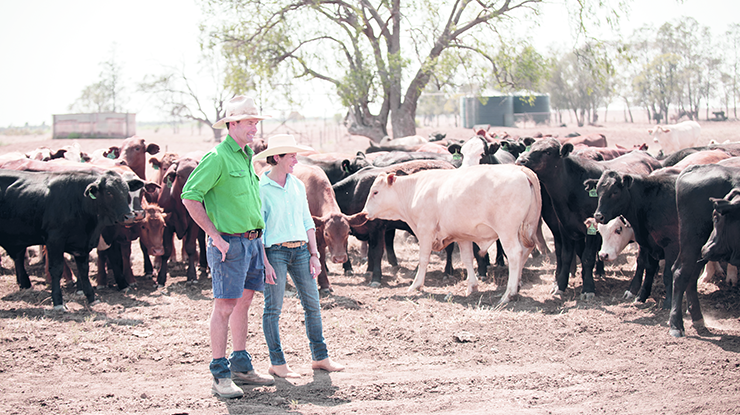 Kate and Geoff Swanson with cattle at ‘Connemara’, Augathella. Image: Katrina Lehmann
Kate and Geoff Swanson with cattle at ‘Connemara’, Augathella. Image: Katrina Lehmann
Journey towards greater control
South‑west Queensland producers Geoff and Kate Swanson use training and education to improve how they manage the profit drivers in their Augathella cattle backgrounding business.
“I’ve always said our business is very simple,” Geoff said.
“Three things have an impact on how well we do: the price we buy cattle for, how quickly they gain weight and the price we sell them for.”
Their strategy is to:
- buy crossbred steers with low Bos indicus content at 250kg at the Roma saleyards during winter
- add 180kg/head by utilising spring and summer‑growing pastures
- sell steers from January to April at an average 430kg to feedlots for finishing.
Profitable interventions
Geoff and Kate have identified two management interventions which could have the greatest impact on their bottom line: speeding up the rate of growth and setting climatic trigger points to adjust numbers.
To support how they take control, they signed up for MLA’s Nutrition EDGE workshop, followed by a Profitable Grazing Systems coaching group run by Nutrition EDGE deliverer and animal nutritionist Désirée Jackson.
“Nutrition EDGE taught me the biggest limiting factor in our business was how much energy we could supply to those steers,” Geoff said.
“It also showed us the faster we got the steers on to good nutrition, the faster they took off when the pastures picked up.
“We’ve often had cattle sitting here at the end of winter doing nothing on frosted pastures so we either have to purchase them later or start supplementing them.”
The Swansons replaced urea‑based supplements with a cottonseed ration which is fed out in tubs at 3kg/head, every three days.
“It’s hard to get your head around the expense of it, but when you examine it carefully, as we did with Désirée, and work out exactly how much energy the cattle need to perform, it makes perfect sense,” Geoff said.
The Swansons have also introduced regular diet‑quality testing (functional near‑infrared reflectance spectroscopy, or dung testing) to identify nutritional deficiencies and nutrient balance.
“We’re not in a traditionally phosphorus‑deficient area but, maybe in a very wet season, dung testing will tell us if phosphorus supplementation might be needed,” Geoff said.
“Once you understand the digestive system of cattle, it helps you make decisions about what you feed them. You always go back to that knowledge rather than trying something just for the sake of it.”
The training also provided techniques for pasture improvement. As buffel grass runs down, Geoff plans to lift pasture quality and quantity by adding a legume component and using cool‑burn management techniques.
Geoff said he found the group learning component of Nutrition EDGE very beneficial as it held him accountable.
“It also allowed Désirée to get to know our business and our goals and now we can ring her and she helps keep us on track.”



